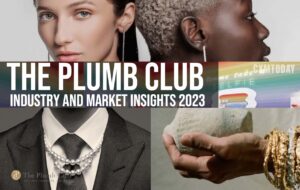By Jennifer Heebner, Editor in Chief
Yesterday, the Plumb Club held a webinar sharing insights from a new consumer jewelry survey it conducted with research firm Qualtrix and assistance from Paola Deluca, The Futurist Ltd. The Plumb Club is a coalition of more than 50 suppliers in the jewelry and watch industry and is celebrating its 40th anniversary this year.
The multifaceted research study was conducted with a sampling of over 2,000 men and women from the ages of 25–60. Respondents represented a balanced demographic and psychographic mix across the U.S., had attended some college, and had a combined annual household income of at least $75,000. The goal of the survey was to understand how individuals engage with jewelry.

Panelists included Lawrence Hess, Plumb Club Executive Director; Steven Lerche, COO of Goldstar Jewellery; and Jordan Peck, Director of Operations for Brevani. The moderator was yours truly.
Value and Category Breakdown
Survey findings included a bird’s eye view of the state of the global industry and growth projections. Today, the international fine jewelry industry is valued at $250 billion, a sum that is expected to double in the next 10 years. Gold jewelry sales account for about $55 billion worldwide while Diamond jewelry accounts for 54% of all jewelry sales. Lab-grown Diamonds are also growing in acceptance among consumers thanks to education by brands and retailers, though more is always better.
“Forty-one percent of consumers can correctly define what a lab-grown Diamond is,” says Peck. “And while 75% of consumers still prefer to buy natural Diamonds, 80% are open to the alternative. Right now, one in every four Diamond jewelry sales is a lab-grown Diamond piece.”
Still, demand for colored gemstones and cultured Pearls isn’t too shabby: Pearls are the third most popular gift to give after Diamonds and Sapphires.
In wedding jewelry, Diamonds are still king. Eighty-six percent of those surveyed said Diamonds are preferred for engagement rings, period. Plus, consumers start their research online but most end up buying in store.
“Sixty-seven percent of Diamond rings—be they engagement, band, or fashion—are purchased in store,” observes Lurche, whose company makes wedding jewelry. “That’s an overwhelming number of ring purchases that are still happening in brick-and-mortar stores.”
Multichannel is Key
What’s driving consumers in stores is a seamless experience online. Consumers browse online first to see what is available, then head to the store to buy, making a strong and easy-to-use multichannel experience super important. “It will give your store a leg up with consumer confidence,” says Peck.
Sixty-two percent of those surveyed bought jewelry online, a sum that will only increase. Convenience and variety of product help in that arena. In fact, a retailer’s website is more significant in driving purchases than most realize. “Seventy percent of those surveyed search the Internet, including retailers’ websites, before visiting a store to purchase,” says Hess.
Social media presence is equally important. Eighty percent of respondents said they were driven to buy from an ad on social media, and another 80% still use Facebook and Instagram most (not TikTok). “Eighty-three percent of those surveyed are active on social media,” adds Hess.
One opportunity for merchants: Improve your social media to get clients to better engage. “Most surveyed said they don’t follow their local jeweler on social media,” says Peck.
More Findings
Other notable themes from the webinar include points about Millennial spending (it’s massive), an interest in sustainability, continued growth of the secondary watch market, and that 24% of respondents said they don’t need a reason to buy jewelry—they just do.
Over 40% of consumers surveyed would pay more to buy jewelry from firms with responsible practices. Store appearance also matters. “No surprise there—you need to be ‘meeting the vibe,’” jokes Lurche, using a phrase from the Millennial’s urban dictionary.
Another point to be mindful of: consumers need to see themselves reflected in your brand if you want people to buy from your store. “Branding used to be about hopes and dreams, but now it has to include diversity, responsible business practices, and current technology,” says Hess.
A full recording of the webinar will be live by next week at plumbclub.com. Interested parties can dig into the entire survey at a seminar to be held June 4 at JCK Las Vegas. To learn more, connect with a Plumb Club member—see the directory on plumbclub.com.
This is proprietary content for AGTA and may not be reproduced.
